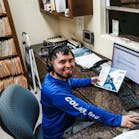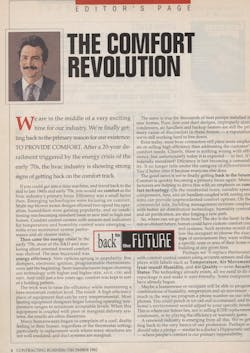Many in our industry invite me to share the story of air balancing as I have experienced it during my career with increasing frequency. I want to thank each of you who have read at least a few of nearly a thousand articles I've written over more than 30 years. You have allowed me to record what happened and why it happened, as it happened. Here's a summary of the history of air balancing in the HVAC industry.
In the Beginning, there was Air
Air is the first word in air conditioning. In the early 1980's everyone talked about it and assumed it was acceptable. Very few had any idea how to measure and verify it. There were four books written about balancing air, and less than 1000 people were certified to test and balance it.
I want to thank each of you who have read at least a few of nearly a thousand articles I've written over more than 30 years.
In the mid-1970s, a fellow named Ernie Shortridge* (founder of Shortridge Instruments) invented what he called a "Flowhood®," and I wanted one. Having entered our 35-year-old family company on the management side, I had zero technical knowledge. Part of my job was to receive customer complaints; most were somehow related to airflow. When I asked the guys in the shop for answers, I got nothing.
Eventually, my career migrated into sales. I followed industry tradition and replaced equipment but had little confidence I was properly serving my customers.Something was missing. Each month I noticed an advertisement for Ernie's flowhood in Contracting Business magazine. I knew I had to have one to figure out our complaints.
A customer named Sam Bartlett had a tenant with 50 occupants threatening to break a lease because of low productivity due to a lack of comfort. I promised we could fix the problem by replacing the duct systems, and for an additional $2500 upfront, I would prove it by measuring airflow. We started the duct upgrade job, and I ordered the flowhood.
After completing the job, I measured airflow and compared it to the design airflow we should have. Our systems delivered airflow was 40% low. So, the next day, I called in the install crew, and we spent a 12-hour day upsizing ducts and adjusting them to match design airflow. Finally, we delivered on our promise.
After a night of little sleep followed by weeks of testing, I talked to everyone I thought would have an answer about why airflow was so low. I soon learned everyone assumed airflow was automatically 400 cfm per ton and that I should leave well enough alone. Nobody in the industry believed me, and most thought I was nuts.
As we continued testing airflow, our customers loved it. We could reveal unseen issues they knew they had but didn't understand until we measured them. That step made airflow visible, and customers were willing to have their systems fixed.
We found an untapped market with no competition. We proved that we delivered what we promised our customers. It was a win for everyone.
The Door Opened Wider
It quickly became apparent that our new construction plan-and-spec balancing skills were just the tip of the iceberg. As an HVAC contractor, we discovered there was much more we could do with residential and light commercial air balancing. Every job was a new adventure that helped us learn to engage customers in testing and diagnostics. Their satisfaction and our success skyrocketed.
Then, in the early 1990s, a man named Jeff Forker, publisher of Contracting Businessmagazine, heard from a contractor friend named Jim Brown, one of thegodfathers of our industry, that this Falke kid had a story to tell. So Jeff sent the magazine's editor, a guy named Dominick Guarino, to investigate. Dominick had recently written and published a series of articles calling for the industry to deliver higher levels of comfort and efficiency. He hoped this airflow testing idea might take his idea to the next level.
Following our first meeting and after a long night of little sleep and endless imagination about what we could do with this airflow thing, a fuzzy picture of the future took shape. We believed together it was our job to bring this opportunity to the industry.
Several months later, Dominick and I found ourselves stuck together at the Dallas-Ft. Worth airport after a flight cancellation. We spent another sleepless night that took our vision to the next level. It became obvious that a training company would be the vehicle to deliver the knowledge and reveal our vision and opportunity to the HVAC Industry. Teaching would be the best way to invite and enable others to practice what we both knew was true.
We Begin to Teach
While still holding other full-time jobs serving the industry, we worked within the available time to launch a training company. Dominick came up with the name National Comfort Institute. A name and brand that continues to grow and strengthen to this day.
It took a few years to write more articles, present at industry conferences, create balancing reports, write procedures, and assemble our first training manual. With support from Southern California Air Conditioning Distributors in City of Industry, CA, in 1993, we held our first training event.
It took several more years to write a certification exam and five years to certify our first 1000 air balancers. Our office was in a small room above a sheet metal shop where we had to hang up the phone when tin knockers began pounding sheet metal below.
The demand for knowledge from our students drove innovation and required separate commercial and residential balancing courses.
Headquarters Moves to Ohio
Soon it became clear to keep up with the increasing training demand for air balancers, NCI needed to gather under one roof. We moved headquarters from Central California to the Cleveland, Ohio, area. Training and support staff grew as the volume of students swelled. The need for a wider variety of balancing certifications expanded. Soon the number of trained balancing professionals exceeded 5,000.
Diagnostics
Meanwhile, fieldwork in new balancing companies began to shift from new construction to troubleshooting existing building HVAC systems. The margins became higher, and since many new certified balancers had an HVAC contracting background, system renovation became a natural extension of the diagnostics.
Soon, staring at columns of field data in faxed balancing reports began to make sense. We saw that the interactions and relationships between the numbers and basic physics could help us understand how the field data moved predictably. This taught us how system defects could be pinpointed and repaired with surgical accuracy.
The field data's profound truth allowed us to solve thousands of problems invisible to most technicians. We found that usual refrigerant, combustion, and electrical testing patterns were incomplete and inaccurate without air-side diagnostics.
Adding diagnostics into NCI's curriculum and how to incorporate it into a company's business model was another giant leap forward. Diagnostics enabled students to find problems and immediately resolve issues previously hidden from them. More importantly, this type of work sold at extremely high margins that customers were willing to pay because they could see the solutions they purchased were a good value.
Decades Pass
Where once we talked of what air balancing could be, now we hustled to keep up with what it was becoming. In the 2000s, I developed ComfortMaxx™ software to capture, calculate, and score HVAC system performance.
We needed to add combustion testing to our curriculum to measure serious deficiencies in installed system heating capacity. As an added benefit, Carbon Monoxide (CO) certified professionals have saved thousands of lives by preventing CO poisonings. So we capitalized on the curious talents of the great Jim Davis.
We then added National Balancing Council, a large building air and water balancing certification program to NCI's list of available balancing certifications. The number of balancing certifications we offered increased to more than 10 while the organization trained more than 3000 professionals each year.
Next, NCI opened a training center under the guidance of Scott Johnson in Southern California. Air balancing entered utility energy savings programs. Official studies confirmed the measured performance of typical systems was below 50% of laboratory-rated capacity.
For nearly 20 years, certified balancing professionals have learned and practiced scoring the installed HVAC system performance. The time came to give that technology to the industry and subject the test and calculation method to the public review process.
ASHRAE (the American Society of Heating, Refrigeration, and Air Conditioning Engineers) agreed to form a committee to write and legitimize a new industry standard. After five years of work by a dedicated committee, ANSI/ASHRAE Standard 221 was published. This standard adds a new dimension to the balancing and contracting professions and brings diagnostics and solutions within reach of all who will embrace the opportunity.
During a recent interview, we were asked about NCI's message and hope for the HVAC industry. The answer confirms that the original air balancing vision remains alive: "The typical heating or cooling system delivers only 50% of its rated capacity into the building. Capable contractors can measure, sell, and improve installed system capacity to nearly 90%. This is a universal product offered with little or no competition."
Rob "Doc" Falke serves the industry as president of National Comfort Institute, Inc., an HVAC-based training company and membership organization. You can contact Doc at ncilink.com/ContactMe or call him at 800-633-7058. Go to NCI's website at nationalcomfortinstitute.com for free information, articles, downloads, and current training opportunities.
* ED. NOTE: Ernie Shortridge passed away in 2004 in Scottsdale, Ariz. Here is his obituary.











